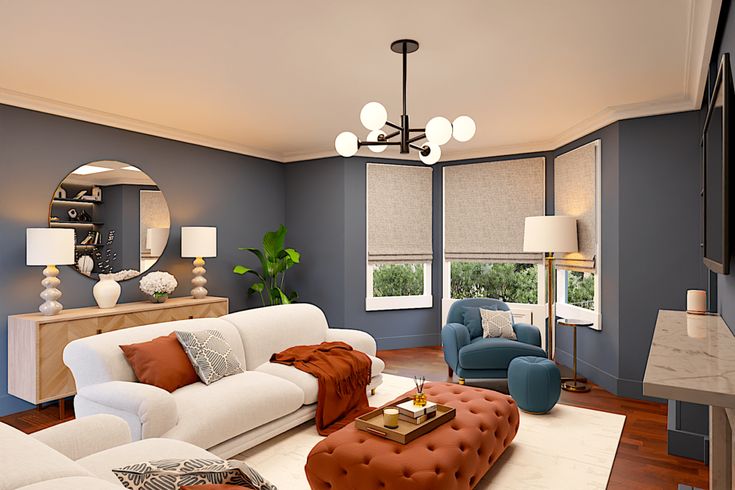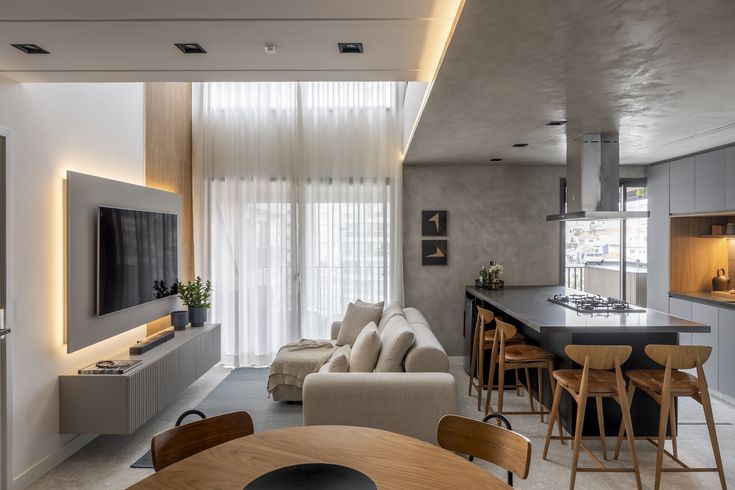Conversation-Ready Living Rooms: Arranging Furniture for Connection
Conversation-Ready Living Rooms: Arranging Furniture for Connection – Creating a living room designed for meaningful conversation can transform your home into a warm and inviting space. By strategically arranging furniture and incorporating thoughtful design elements, you can foster a sense of connection, intimacy, and comfort among family and friends. This article explores practical tips, design ideas, and principles to help you craft the perfect conversation-ready living room.
1. The Importance of Layout for Connection
The layout of a living room plays a crucial role in promoting conversation. A well-designed room encourages interaction, while a poorly arranged space can create barriers. By considering flow, symmetry, and balance, you can set the stage for engaging discussions and quality time.
2. Start with a Focal Point
Every inviting living room needs a focal point to anchor the design. Common focal points include fireplaces, large windows, artwork, or a statement piece of furniture. Once the focal point is identified, arrange seating around it in a way that feels cohesive and natural. For instance, if your focal point is a fireplace, position sofas and chairs to highlight it while keeping them close enough for conversation.
3. Arrange Furniture for Inclusivity
To make your living room conversation-ready, focus on inclusive seating arrangements. Avoid placing furniture against walls unless necessary; instead, pull seating closer together. Aim to create a circular or semi-circular layout, as it allows everyone to make eye contact and feel part of the conversation.
- Group seating: Use a combination of sofas, armchairs, and loveseats to create inviting clusters.
- Equal spacing: Ensure that seating is evenly spaced to avoid anyone feeling left out.
- Flexibility: Include movable furniture like ottomans or stools that can be repositioned as needed.
4. Choose the Right Coffee Table
A coffee table acts as both a functional and aesthetic element in your living room. Select a table that’s proportional to your seating arrangement and provides easy access for everyone. For added connection, opt for a round or oval table to complement a circular seating layout and encourage inclusivity.
5. Optimize Traffic Flow
Smooth traffic flow is essential in a conversation-ready living room. Ensure there is enough space for people to move around comfortably without disrupting the seating arrangement. Leave at least 18-24 inches of space between furniture pieces to create a balanced environment.
6. Incorporate Cozy Textures
Comfort is key to fostering connection, and incorporating soft, cozy textures can make your living room feel more inviting. Use plush cushions, throws, and rugs to add warmth and personality. Layering different textures—such as a woolen blanket over a leather sofa or a fluffy rug underfoot—creates visual interest and comfort.
7. Lighting for Ambiance
Lighting significantly impacts the mood of a room. Aim for a layered lighting design that combines ambient, task, and accent lighting to create a welcoming atmosphere.
- Ambient lighting: Use ceiling lights or recessed lighting to provide overall illumination.
- Task lighting: Add table lamps or floor lamps near seating areas for reading or focused activities.
- Accent lighting: Highlight artwork, architectural features, or decorative objects with spotlights or wall sconces.
Dimmable lighting options allow you to adjust the brightness to suit the mood, making it easier to transition from casual gatherings to more intimate conversations.
8. Add Personal Touches
Infuse your living room with personality by including personal touches that reflect your style and interests. Display family photos, travel souvenirs, or a curated collection of books on shelves or coffee tables. These items can spark conversations and make the space feel uniquely yours.
9. Incorporate Nature
Bringing nature indoors can create a calming and welcoming environment. Use houseplants, floral arrangements, or natural materials like wood and stone to add a touch of nature. Plants not only enhance the aesthetics but also improve air quality and contribute to a sense of well-being.
10. Embrace Technology Mindfully
While technology often plays a central role in modern living rooms, it’s essential to strike a balance between connectivity and conversation. Consider minimizing the prominence of screens by hiding the television when not in use or incorporating a media cabinet. Alternatively, designate certain areas of the living room as tech-free zones to encourage face-to-face interaction.
11. Use Color Psychology
Colors influence mood and can impact the quality of interactions. Warm tones like beige, taupe, or muted orange create a cozy and inviting atmosphere, while cool tones like blue and green promote calmness. Balance bold colors with neutral shades to avoid overwhelming the space.
12. Leverage Multi-Functional Furniture
Multi-functional furniture can enhance your living room’s versatility, especially in smaller spaces. Consider items like:
- Storage ottomans that double as seating or footrests.
- Nesting tables that can be expanded for larger gatherings.
- Sofa beds for accommodating overnight guests.
These pieces allow you to adapt the space to different needs without compromising on style or comfort.
13. Pay Attention to Acoustics
Good acoustics are essential for a conversation-friendly environment. Hard surfaces can create echo, making it difficult to hear, while soft materials absorb sound and improve clarity. To optimize acoustics:
- Use area rugs to dampen sound.
- Add curtains or fabric wall hangings.
- Incorporate upholstered furniture.
14. Balance Symmetry and Asymmetry
Achieving the right balance between symmetry and asymmetry can add visual interest to your living room. Symmetrical arrangements—like matching armchairs flanking a sofa—create a sense of order and formality. Asymmetrical layouts, on the other hand, feel more dynamic and casual. Combining both elements can make the space feel balanced yet relaxed.
15. Create Zones for Interaction
If your living room is spacious, consider dividing it into zones to accommodate different activities. For example:
- A primary seating area for group conversations.
- A secondary nook with a pair of armchairs for one-on-one chats.
- A reading corner with a comfortable chair and a small side table.
Use rugs, furniture placement, or lighting to define these zones without disrupting the overall flow.
16. Keep It Clutter-Free
A cluttered living room can feel chaotic and uninviting. Keep the space organized by using smart storage solutions like built-in shelves, baskets, or cabinets. Regularly decluttering and organizing ensures that your living room remains a relaxing and conversation-ready space.
17. Test and Adjust
Finally, don’t be afraid to experiment with your living room arrangement. Try different layouts, swap furniture pieces, or add new decor items to see what works best for your space. Pay attention to how people interact in the room and adjust as needed to enhance comfort and connection.
Conclusion
Designing a conversation-ready living room requires thoughtful planning and attention to detail. By focusing on layout, comfort, lighting, and personalization, you can create a space that encourages meaningful connections and memorable moments. Whether you’re hosting a lively gathering or enjoying a quiet evening with loved ones, your living room will become a welcoming haven for conversation and connection.






